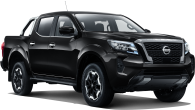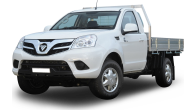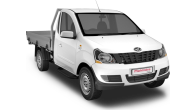The Triton is one of Australia's most popular utes but you wouldn't know it if you weren't aware of sales figures or didn't take any notice of their growing presence on our roads. The Triton range continues to thrive with great value-for-money propositions, but is the top-spec Exceed worth the extra cash? Read on.
Mitsubishi Triton 2018: Exceed (4x4)
| Engine Type | Diesel Turbo 4, 2.4L |
|---|---|
| Fuel Type | Diesel |
| Fuel Efficiency | 7.6L/100km (combined) |
| Seating | 5 |
| Price From | $24,200 - $29,810 |
| Safety Rating |
|
Does it represent good value for the price? What features does it come with?
The top-of-the-shelf Exceed's list price is $48,000, but our test vehicle costs $49,703 because it has the metallic paint ($590) and tow bar and tow ball ($1113, parts and fitment). Even with extra-cost options the Exceed is still at least $4000 cheaper than its closest-in-price rival, the $54,490 Nissan Navara ST-X, which remains one of the more affordable top-spec utes available.
.JPG)
And for the Exceed's relatively low price you get a nice-looking dual-cab ute packed with features including 7.0-inch multimedia touchscreen (with Apple CarPlay, Android Auto and six-speaker audio system), leather-bound gear-knob, steering wheel (with paddle shifters) and seats (also heated), as well as dual-zone climate control, keyless entry, dusk-sensing HID headlights, LED daytime running lights and fog-lights, wing mirrors with indicators, alloy side-steps, chrome sports bar and chrome accents, 17-inch 'diamond-patterned' alloys, and rear diff lock.
All Exceeds are only available as auto dual-cabs.
Active safety aids include emergency stop signal function, ABS with electronic brakeforce distribution, active stability and traction control, emergency brake assist system, reversing camera, as well as hill start assist and trailer stability assist. It does not have AEB.
What are the key stats for the engine and transmission?
The Triton has a proven 2.4-litre four-cylinder turbo-diesel engine, which produces 133kW at 3500rpm and 430Nm at 2500rpm. It's a willing, gutsy unit, well matched to the smooth five-speed automatic transmission and Mitsubishi's 'Super Select II' 4x4 system.
.JPG)
Is there anything interesting about its design?
.JPG)
It's a sharp-looking unit this Triton. The whole range has a polarising rocketship-cool appearance about it – all sculpted, scooped and swooping – but the Exceed adds a touch of polish and cool tweaks to the inside and out that set it apart from other Triton variants.
Its diamond-patterned wheels are definitely eye-catching for better or worse, chrome accents inside are very tastefully done, and the overall feel of refinement lands fair-square in 'premium' territory.
How practical is the space inside?
.JPG)
Its build quality is top-notch – everything works smoothly and is neat and tidy – and comfort levels are excellent for something at this price-point.
Triton controls, as always, are easy to locate and operate and, in Exceed trim, are capped with top-spec gloss. The multimedia touchscreen is clear and bright and simple to use.
The Triton is quite a bit smaller than many of its rivals, dimensions-wise, therefore its interior room is somewhat confined compared to those competitors – and at times it feels so. However, storage spaces are still in abundance, showing that designers have really maximised the available space.
There is an overhead sunglass stash-spot, deep glovebox, and centre console (including bits-and-pieces space upfront, two cupholders and a storage box with lid).
.JPG)
For those in the back seat, there are back-of-front-seat pockets, bottleholders in both doors and a fold-down centre arm-rest with two cupholders.
Seats are wrap-around-you comfortable – or maybe I just don't get out much. Taller people – those smug mongrels! – have sometimes complained about the Triton's short seat bases. Being one of the original Seven Dwarfs, I was fine.
The rear seat is okay with three passengers for short trips, but better generally with two in there – even if it's only kids.
The Triton's tray is 1520mm long, 1470mm wide and 475mm deep, but when throwing gear in the back, keep in mind a fair chunk of its load space is behind the rear axle so distribute the weight as far forward as you can.
What's it like as a daily driver?
.JPG)
The Exceed is 5280mm long (with a 3000mm wheelbase), 1815mm wide, 1780mm high, and has a listed kerb mass of 1950kg. It has an 11.8m turning circle.
Compared to rivals, the Triton is a lightweight in terms of bulk and beefiness, but its dimensions almost always work in its favour on- and off-road. It's light and, with that well-weighted (tilt-and-telescopic-adjustable) steering, is very easy to manoeuvre through clogged city streets, parked-up suburban routes and, more about this later, tight bush tracks.
But because it's on the small side of things and door openings are narrower, getting in and out is a stepping-turning-twisting move; easy for me (I'm agile that way) but its ingress and egress can be on the wrong side of difficult for others.
.JPG)
Visibility is generally good all-round, except where it becomes pinched by design in the second-row windows and through the rear.
The 2.0-litre engine is a real punchy unit, ready and willing off the mark and swiftly responsive when the Triton is called upon to overtake at speed on the move. The five-speed auto – an oddity in a world full of autos heading for 10-speed land – is a smooth shifter in auto or manual mode, in which you can use the steering-wheel-mounted paddles for gear changes.
The Exceed has coil springs at the front and leaf springs at the rear and it rides on 17-inch Bridgestone Dueler H/T tyres. On bitumen, the ride is generally quite settled, only tending towards jittery when the Triton hits a patch of broken blacktop. Obviously, when loaded up with people and gear in the tray, it settles even better.
What's it like for touring?
The Triton is a fun thing to drive because it's like the vehicular version of a point-and-shoot camera or a plug-and-play anything: reliable, supremely easy to use, and lots of fun because you can trust the mechanicals.
Mitsubishi's Super Select II system offers four modes: 2H (two-wheel drive, rear), 4H (4X4 but in an all-wheel drive mode, safe to use at high speed on bitumen), 4H LC (4X4/all-wheel drive with locked centre diff; off-road driving at 30km/h or so) and 4L LC (4X4/all-wheel drive with locked centre diff and crawler gears engaged; only for low-speed 4WDing (below 30km/h). It's a solid system and works well.
As when driving the Triton's stablemate, the Pajero, I like to drive the Exceed in 4H (on bitumen and gravel) for optimum traction – especially on fast gravel tracks. I only ever switched Super Select II from 4H to 4H LC or 4L LC when we tackled tougher sections on our slower-going off-road loop.
The Triton was never rattled although it does take consistent judicious driving to overcome the low-slung side-steps and a departure angle of 22 degrees, due to its tray overhang. The tow ball (on our tester) at the rear didn't help our cause either.
.JPG)
This ute, because of its smaller dimensions relative to its rivals, is easy to navigate through narrow bush tracks, tightly-angled turns and pinched approaches to climbs and descents that would force its larger competitors into repeated back-and-forth manoeuvres.
It has 205mm ground clearance (unladen), and approach and ramp-over angles of 30 degrees and 24 degrees respectively.
The Exceed also has a rear diff lock and heavy-duty skid plates at the front and under the engine for when your off-roading gets really tough.
Maximum payload is 950kg but we never had anywhere near that much onboard, only some camping gear (two swags, camp chairs etc), a stand-up paddleboard and paddles, and a chockers 40-litre Esky.
It has a maximum towing capacity of 3100kg (braked) and 750kg (unbraked). It has a GVM of 2900kg and a GCM of 5885kg.
How much fuel does it consume?
The Exceed has a claimed fuel consumption of 7.6L/100km (combined). We recorded 8.4L/100km for daily driving (including plenty of stop-start driving through city and suburban streets) and then 10.2L/100km for touring (including a fair portion of slow off-roading through soft coastal-bushland sand as well as driving up and down steep shale hills). It has a 75-litre tank.
Warranty & Safety Rating
What safety equipment is fitted? What safety rating?
.JPG)
All Triton variants have had a five-star ANCAP rating since April 2015. The Exceed has driver and front-passenger front and side airbags, driver's knee airbag and full-length side curtain airbags. There are two ISOFIX and two top tether child-restraint anchor points in the rear seat. While it does have a raft of safety aids, it does not have AEB.
What does it cost to own? What warranty is offered?
It has a five-year/100,000km warranty plus five-year corrosion perforation warranty. Servicing is capped-price over three years and is recommended at 12 months/15,000km, 24 months/30,000km and 36 months/45,000km, costing $430, $530 and $550.
Verdict
Mitsubishi packs a stack of gear into its very functional, nice-looking Triton Exceed and keeps the price under $50,000; an impressive achievement in an era when Australia's dual-cab ute market is seemingly dominated by its more expensive rivals. The Exceed is an able all-rounder with plenty of up-market polish but it can still tackle the dirty stuff without hesitation. Bonus: it's a lot of fun to drive. If you're after a high-end 4WD ute that won't empty your bank account and is still capable of respectable off-roading, then the Exceed is worth a look.
What do you think of the Exceed? Tell us in the comments below.
Pricing Guides


.JPG)











.jpg)
.jpg)


.jpg)

.jpg)